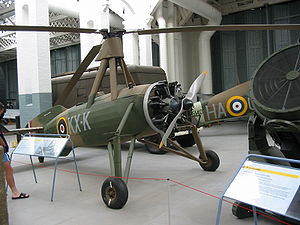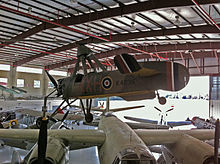- Cierva C.30
-
C.30 Avro 671 Rota Mk 1 at Imperial War Museum, Duxford Role Autogyro Designer Juan de la Cierva First flight 1933 Introduction 1934 Number built 148 Variants Cierva C.40 The Cierva C.30 was an autogiro designed by Juan de la Cierva and built under licence from the Cierva Autogiro Company by A V Roe & Co Ltd (Avro), Lioré-et-Olivier and Focke-Wulf.
Contents
Design and development
Before the experimental Cierva C.19 Mk V, autogiros had been controlled in the same way as fixed-wing aircraft, that is by deflecting the air flowing over moving surfaces such as ailerons, elevators and rudder. At the very low speeds encountered in autogiro flight, particularly during landing, these controls became ineffective. The experimental machine showed that the way forward was to have a tilting rotor hub and a control rod coming down from the hub to the pilot's cockpit with which he could change the rotor plane. This was known as "direct control" and was fitted to the C.30[1]. The production variant, called C.30A in England, was preceded by several development machines.
The first production design in the series was the C.30, a radial-engined autogiro with a three-blade, 37 ft (11.3 m) rotor mounted on an aft-leaning tripod, the control column extending into the rear of the two cockpits. The engine was the five-cylinder, 105 hp (78 kW) Armstrong Siddeley Genet Major I used in the C.19 series. The fabric-covered fuselage carried an unbraced tailplane, without elevators but with turned-up tips. The port side plane had an inverted aerofoil section to offset the roll-axis torque produced in forward flight by the advancing port side blades. As with most autogiros, a high vertical tail was precluded by the sagging resting rotor, so the dorsal fin was long and low, extending well aft of the tailplane like a fixed rudder and augmented by a ventral fin. The wide-track undercarriage had a pair of single, wire-braced legs and a small tail wheel was fitted. This model flew in April 1933. It was followed by four improved machines designated C.30P (P here for pre-production) which differed in having a four-legged pyramidal rotor mounting and a reinforced undercarriage with three struts per side. The rotor could be folded rearwards for transport. The C.30P used the more powerful (140 hp, 104 kW) seven-cylinder Armstrong Siddeley Genet Major IA radial engine.
The production model, called the C.30A by Avro, was built under licence in Britain, France and Germany and was similar to the C.30P. The main alteration was a further increase in undercarriage track with revised strutting, the uppermost leg having a pronounced knee with wire bracing. There was additional bracing to the tailplane and both it and the fin carried small movable trimming surfaces. Each licensee used nationally built engines and used slightly different names. In all, 143 production C.30s were built, making it by far the most numerous pre-war autogiro.
Between 1933 and 1936, de la Cierva used one C.30A (G-ACWF) to perfect his last contribution to autogyro development before his death in a DC-2 (fixed wing) crash in late 1936. To enable the aircraft to take off without forward ground travel, he produced the "Autodynamic" rotor head, which allowed the rotor to be spun up by the engine in the usual way but to higher than take-off r.p.m at zero rotor incidence and then to reach operational positive pitch suddenly enough to jump some 20 ft (6 m) upwards.
At least one of the RAF C.30As was in January 1935 on floats as a Sea Rota[2].
Production
- Avro
Avro obtained the licence in 1934 and subsequently built 78 examples, under their model designation, fitted with an Armstrong Siddeley Genet Major IA (known in the RAF as the Civet 1) 7-cylinder radial engine producing 140 hp (100 kW). The first production C.30A was delivered in July 1934.
- Lioré-et-Olivier
Twenty-five aircraft were built in France by Lioré-et-Olivier as the LeO C.301 with a 175 hp (130 kW) Salmson 9NE 9-cylinder radial engine.
- Focke-Wulf
Forty aircraft were built in Germany by Focke-Wulf as the C 30 Heuschrecke (Grasshopper) with a 140 hp (105 kW) Siemens Sh 14A 7-cylinder radial engine.[3][4]
Operational history
Of the 66 non-RAF aircraft built in the UK by Avro, 37 appeared at least for a while on the UK register[1]. Some (maybe a dozen) were sold on abroad, but others were flown by wealthy enthusiasts and by flying clubs who anticipated autogiro training needs. By the end of the decade private flyers were moving back to the comforts and economies of fixed-wing aircraft and more C.30s moved abroad, leaving the Autogiro Flying Club at London Air Park, Hanworth as the major UK user. 26 aircraft were directly exported by Avro. These went both to private owners and to foreign air forces who wish to investigate the autogiro's potential.
In 1934, one Spanish Navy C.30 piloted by Cierva landed on the Spanish Seaplane tender Dedalo anchored in Valencia harbor and later made a takeoff.[5]
Twelve C.30A built by Avro for the Royal Air Force (RAF) entered service as the Avro 671 Rota Mk 1 (Serials K4230 to K4239 and K4296 & K4775). The twelve were delivered between 1934 to 1935. They equipped the Army School of Co-operation at Old Sarum near Salisbury.
Many of the surviving civil aircraft were also taken into RAF service between 1939 and 1940. In 1940 they equipped No. 1448 Flight at RAF Duxford. Later they equipped No. 529 Squadron RAF at Halton on radar calibration work. They disbanded in October 1945. At the end of the war the twelve survivors were sold.
Most of these did not last long, although two were used for pilot rotary wing experience by Fairey in their Fairey Gyrodyne helicopter programme. Rota Towels kept one ex-RAF Rota airworthy G-AHTZ until an accident in 1958. G-ACUU, the Imperial War Museum's C.30A exhibit at Duxford had one of the longest active lives. It joined Air Service Training Ltd in 1934, was impressed (as Rota HM580) in 1942, serving with 529 Squadron and returning to civil use by G.S. Baker based at Birmingham's Elmdon airport with its original registration plus the nickname Billy Boy and was not withdrawn from use until 1960.
Variants
- C.30
- Powered by a 78-kW (105-hp) Armstrong Siddeley Genet Major I radial piston engine.
- C.30P
- Improved model, powered by a 104-Kw (140-HP) Armstrong Siddeley Genet Major IA radial piston engine.
- C.30A
- Main production model, powered by a 104-kW (140-hp) Armstrong Siddeley Genet Major IA radial piston engine.
- Rota Mk I
- RAF designation of the Cierva C.30A.
Aircraft on display
A C.30 on display at Fantasy of Flight in Polk City, Florida
- Argentina
- Cierva C.30A (LV-FBL) is on display in Argentina.
- Australia
- Cierva C.30A (VH-USR) is on display at the Powerhouse Museum, Sydney.
- France
- Leo C.302 (F-BDAD) is on display at the Musée de l'Air et de l'Espace, Paris.
- Italy
- Cierva C.30 (I-CIER) is on display at the Museo della Scienza e della Tecnologia "Leonardo da Vinci", Milan.
- Netherlands
- Cierva C.30A (SE-AFI) is on display at the Aviodrome.
- Spain
- Cierva C.30A 'flying reproduction' with a Siemens engine (XVU.1-1) is on display at Museo del Aire.
- United Kingdom
- Avro Rota I (K4232) on display at the Royal Air Force Museum, London, England.
- Cierva C.30A (AP506) on display at the Helicopter Museum, Weston-super-Mare, England.
- Cierva C.30A (AP507) on display at the Science Museum in London, England.
- Avro Rota I (HM580) the former G-ACUU is on display at the Imperial War Museum Duxford, England.
- United States
- Cierva C.30A (K4235) on display at Fantasy of Flight, Polk City, Florida.
Military operators
- Belgian Air Force
- Royal Yugoslav Air Force
Specifications (C.30A)
General characteristics
- Crew: one, pilot
- Length: 19 ft 8 in (6 m)
- Rotor diameter: 37 ft (11.28 m)
- Height: 11 ft 1 in (3.38 m)
- Empty weight: 1,220 lb (554.5 kg)
- Loaded weight: 1,800 lb (818 kg)
- Powerplant: 1 × Armstrong Siddeley Genet Major IA 7-cylinder air-cooled radial engine, 140 hp (104 kW)
Performance
- Maximum speed: 110 mph (177 km/h)
- Cruise speed: 95 mph (153 km/h)
- Range: 285 mi (458 km)
- Rate of climb: 700 ft/min (213.4 m/min)
In popular culture
A similar aircraft briefly appears in Alfred Hitchcock's movie The 39 Steps, the first known depiction of an autogiro on film.
An autogiro[clarification needed] appears briefly in Frank Capra's 1934 film It Happened One Night, delivering aviator King Westley to his wedding.
References
Notes
- ^ a b Jackson 1973, p. ?.
- ^ Thetford 1957, p. ?.
- ^ Orbis 1982-1985, p. ?.
- ^ Smith 1973, p. 94.
- ^ La Cierva and the Transportable Station of naval Aeronautic (in Spanish)
Bibliography
- Jackson, A.J. British Civil Aircraft 1919-72: Volume II. London: Putnam and Company, 1973. ISBN 0-85177-813-5
- Munson, Kenneth. Helicopters and other Rotorcraft since 1907 (Blandford Colour Series). London: Associate R.Ae.S., 1973. ISBN 0-7137-06104.
- Pacco, John. "Cierva C-30A" Belgisch Leger/Armee Belge: Het militair Vliegwezen/l'Aeronautique militaire 1930-1940. Artselaar, Belgium, 2003, p. 92. ISBN 90-801136-6-2.
- Smith, J. Richard. "C 30 Heuschrecke" Focke-Wulf, an Aircraft Album. London, Ian Allan, 1973. ISBN 0-7110-0425-0.
- Thetford, Owen. Aircraft of the Royal Air Force 1919-57. London: Putnam and Company, 1957.
- The Illustrated Encyclopedia of Aircraft (Part Work 1982-1985). Orbis Publishing.
External links
- Spanish reproduction maiden flight
- IPMS Stockholm pages for the Cierva C.30 including detail photographs
Avro aircraft Manufacturer designations Type D · Type E · Type F · Type G · Type H
500 · 501 · 502 · 503 · 504 · 508 · 510 · 511 · 513 · 519 · 521 · 522 · 523 · 527 · 528 · 529 · 530 · 531 · 533 · 534 · 536 · 538 · 539 · 545 · 546 · 547 · 548 · 549 · 550 · 551 · 552 · 553 · 554 · 555 · 556 · 557 · 558 · 560 · 561 · 562 · 563 · 566 · 567 · 571 · 572 · 574 · 575 · 576 · 578 · 578 · 580 · 581 · 584 · 586 · 587 · 594 · 597 · 604 · 605 · 608 · 609 · 611 · 612 · 613 · 616 · 617 · 618 · 619 · 620 · 621 · 624 · 625 · 626 · 627 · 631 · 632 · 633 · 636 · 637 · 638 · 639 · 640 · 641 · 642 · 643 · 644 · 646 · 652 · 655 · 656 · 663 · 664 · 665 · 666 · 668 · 670 · 671 · 672 · 674 · 675 · 679 · 680 · 681 · 682 · 683 · 684 · 685 · 686 · 688 · 689 · 691 · 682 · 694 · 695 · 696 · 698 · 701 · 706 · 707 · 711 · 720 · 721 · 724 · 726 · 728 · 729 · 730 · 731 · 732 · 735 · 748 · 776 · 784
By role BombersTransportsAndover · Lancastrian · York
Maritime patrolAnson · Bison · Shackleton
Passenger transportsTrainersFightersSports planesExperimentalAero enginesA.V. Roe 20 hp 2-cyl.
Aircraft produced by Cierva/Cierva Autogiro Company/Weir Lists relating to aviation General Aircraft (manufacturers) · Aircraft engines (manufacturers) · Airlines (defunct) · Airports · Civil authorities · Museums · Registration prefixes · Rotorcraft (manufacturers) · TimelineMilitary Accidents/incidents Records Categories:- Autogyros
- Propeller aircraft
- Single-engine aircraft
Wikimedia Foundation. 2010.



